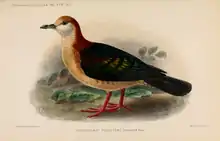| Henicophaps | |
|---|---|
 | |
| New Britain bronzewing, Henicophaps foersteri | |
| Scientific classification | |
| Domain: | Eukaryota |
| Kingdom: | Animalia |
| Phylum: | Chordata |
| Class: | Aves |
| Order: | Columbiformes |
| Family: | Columbidae |
| Subfamily: | Columbinae |
| Genus: | Henicophaps G.R. Gray, 1862 |
| Type species | |
| Henicophaps albifrons Gray GR, 1862 | |
| Species | |
|
See text | |
Henicophaps is a small genus of doves that are endemic to New Guinea and the Bismarck Archipelago. These are stocky pigeons with unusually long heavy bills that live in wet forests and forage primary on the ground.
English zoologist George Robert Gray introduced the genus Henicophaps in 1862 to accommodate the New Guinea bronzewing (Henicophaps albifrons) that had been collected by the naturalist Alfred Russel Wallace on the island of Waigeo, northwest New Guinea.[1] The genus name combines the Ancient Greek henikos meaning "unique" and "phaps" meaning "pigeon".[2]
The genus includes two species.[3]
- New Guinea bronzewing (Henicophaps albifrons)
- New Britain bronzewing (Henicophaps foersteri)
References
- ↑ Gray, George Robert (1861). "Remarks on, and descriptions of, new species of birds lately sent by Mr. A. R. Wallace from Waigiou, Mysol, and Gagie Islands". Proceedings of the Zoological Society of London (Part 3): 427–438 [432]. The title page is dated 1861 but Part 3 was not published until the following year.
- ↑ Jobling, James A. (2010). The Helm Dictionary of Scientific Bird Names. London: Christopher Helm. p. 190. ISBN 978-1-4081-2501-4.
- ↑ Gill, Frank; Donsker, David; Rasmussen, Pamela, eds. (2020). "Pigeons". IOC World Bird List Version 10.1. International Ornithologists' Union. Retrieved 16 March 2020.
This article is issued from Wikipedia. The text is licensed under Creative Commons - Attribution - Sharealike. Additional terms may apply for the media files.